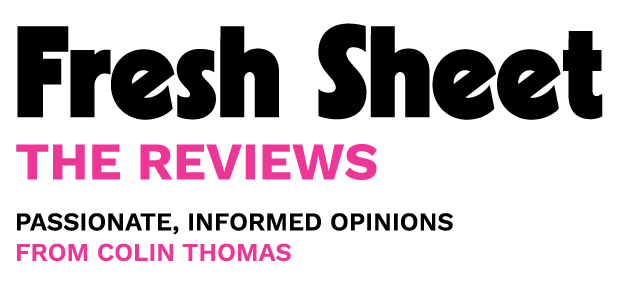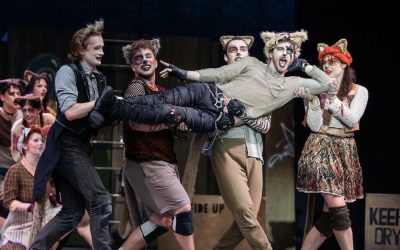
Paul Herbert, Chelsea MacDonald, and Brian Parkinson (Photo by Nancy Caldwell)
There are several layers of experimentation going on here. Some of them work. A couple work splendidly.
Playwright Lucas Hnath really does present A Public Reading of an Unproduced Screenplay about the Death of Walt Disney as a public reading. Four actors file onstage, carrying their screenplays in black binders, and sit at a long table. “I’m Walt Disney,” one of them says. “This is a screenplay I wrote. It’s about me.”
Talk about a thesis statement: A Public Reading is an examination of megalomania.
Disney was one of the architects of the American dream as it was understood in the ‘50s and ‘60s — or, in Lucas Hnath’s version of the Disney character, one of the country’s biggest liars. In 1958, White Wilderness, one of Disney’s “True-Life Adventure” nature documentaries, won an Academy Award. Its most startling scene documents a mass lemming suicide — except lemmings don’t commit suicide. That’s a myth. The filmmakers herded lemmings off a cliff and were later accused of animal cruelty.
Whether or not Disney knew about this is up for debate, but Hnath isn’t after historical accuracy: he’s riffing on the facts and myths of Disney’s life to hunt bigger thematic game. A Public Reading exposes the deceit of the lemming suicide, but it also presents, without questioning it, the urban legend that Disney had his head cryonically frozen. Hnath isn’t claiming to be a documentarian, he’s using Disney as a mythical figure that allows him to explore American individualism, its expression in capitalism, and its tendency towards fascism.
In real life, Disney tried to establish a utopian city attached to Disney World in Orlando, Florida — utopian in his terms, at least. As Walt’s brother Roy points out in the play, the citizens of this city would have no voting rights; jurisdictional authority would be Walt’s alone.
Ever the propagandist, the play’s Walt says, “If you can’t see the problems, to see the problems as problems, there are no problems.” Hnath’s Disney is a player in an anaesthetic entertainment industry that renders invisible the inequities of capitalism.
That sentence, “the problems … the problems … the problems”, reveals at the incantatory nature of Hnath’s text. With all of its characters sitting at a table, reading — physical action stripped away — A Public Reading is designed to cast a rhythmic linguistic spell.
Playing Disney, Paul Herbert delivers his lines like a wizard. Every utterance is informed by so much intention that even sentence fragments carry volumes of meaning. Unleashed transgression can be very funny and, by freely embracing his character’s careening selfishness and pettiness, Herbert also allows us to enjoy their forbidden comic fruits.
Chelsea MacDonald delivers an emotionally loaded characterization as Disney’s child, who is identified in the script as Daughter. She’s pregnant and Disney wants her to name her third son after him. Explaining why she has no such intention, she coolly lets him have it: “Because when I say your name, I think all sorts of things I don’t want to think. When I say your name, I think of you, and when I think of you, I get all angry …”
After being silent for most of the evening, Ryan Trieus barges his way into the proceedings — appropriately — as Disney’s son-in-law Ron, a former football player eager to succeed in the patriarchal world of his father-in-law’s business. A Public Reading is musical, it consists of linguistic solos, duets, trios, and quartets, and Trieus understands Ron’s role in this: Ron’s not too bright and, with his blunt cadences, he is like a base-level percussionist.
Unfortunately, this sense of musicality is largely lost on one member of the ensemble, Brian Parkinson, who’s playing the crucial role of Walt’s brother Roy. As written, the character tends towards passivity, but Parkinson’s performance falls all the way into flatness: it feels like he’s just reading his lines — and that drags things down.
This adds to other problems. Although I’ve had a good time articulating my understanding of the play’s thematic content in this review, watching the show, I found it easily graspable and unsurprising. As I’ve mentioned, Hnath’s physical framing is deliberately static. Because of these factors — and the rhythmic misfire — my eyes started scanning for the play’s exit door long before it was revealed.
I also question elements of director Adam Henderson’s interpretation. In his program notes, he freely admits that, in the script, playwright Hnath calls for minimalist staging, but Henderson reasons that, because we’re emerging from the pandemic (maybe) and we’re hungry for theatricality, the audience in this moment deserves more.
In some instances, that’s a mistake. One wall of Todd Parker’s corporate-boardroom set features a striking piece of wall sculpture. It’s superfluous. More mistakenly, Henderson incorporates slides. Daughter clicks her way through a carousel’s worth of images drawn by Julia Henderson. When they try to imitate the Disney studio’s style, they’re not skilled enough to carry it off. And they impose a distracting interpretive layer: when Disney kills an iconic tree to create Disney World, for instance, images of the tree as a set of lungs are placed in parallel with images of Disney’s own cancer-infected lungs. Who needs it?
But there is also one magnificent gesture. Disney’s megalomania — his obsession with control, his legacy, and immortality — is an indirect admission of his fear of disappearing. The final speech that Hnath gives the character at the moment of his death is transcendent in its poetry. And, under Henderson’s direction, projection designer Nicco Dicecco floods the playing area with images that make us feel like we’re passing through the synapses of Disney’s brain. Its breathtaking.
In that speech — and in actor Herbert’s tender delivery — we see the real tragedy of this Disney’s life and of capitalism, the system it stands for: the tragedy of loneliness.
A PUBLIC READING OF AN UNPRODUCED SCREENPLAY ABOUT THE DEATH OF WALT DISNEY By Lucas Hnath. Directed by Adam Henderson. A United Players production. At the Jericho Arts Centre on Friday, March 25. Continues until April 17. Tickets
NEVER MISS A REVIEW: Sign up for FRESH SHEET, my weekly e-letter about the arts.
And, if you want to help to keep independent arts criticism alive in Vancouver, check out my Patreon page.





0 Comments